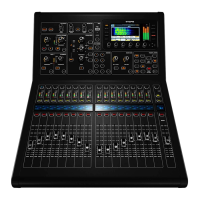46 DIGITAL RACK MIXER M32R User Manual
Dual Graphic EQ / Stereo Graphic EQ / Dual TruEQ /
Stereo TruEQ
There are four standard graphic EQs that provide 31 bands of adjustment
between 20 Hz and 20 kHz. A master volume slider compensates for changes
in volume caused by the EQ. A maximum boost or cut of 15 dB is available for
each band.
The TruEQ incorporates a special algorithm that compensates for the gain
adjustment overlapping eect that adjacent frequency bands have on one
another. On a standard EQ, when neighbouring bands are boosted together,
the resulting eect is magnied beyond what is visible from the positioning of
the sliders.
This compensated EQ will produce an adjustment that is identical to the actual
positioning of the sliders.
Graphic EQ without frequency response correction.
Graphic EQ with frequency response correction.
Dual DeEsser / Stereo DeEsser
De-essing is an audio eect designed to reduce the amount of excessive sibilance
in an audio signal, usually when dealing with the human voice. The Dual DeEsser
accurately and seamlessly removes sibilance from audio tracks.
The Lo-Band and Hi-Band controls select which portion of the audio spectrum
is aected by the DeEsser on each channel. By increasing the amount of
reduction, the level to which the de-essing aects the input signal can be
controlled. By pressing the rst and third push encoders, the eect can be
targeted specically at male or female voices.
With the Stereo DeEsser, toggle between Stereo and M/S modes by pressing the
fth push encoder.
Stereo Xtec EQ1 / Dual Xtec EQ1
Virtually indescribable, recording engineers claim this vintage EQ to be the
“secret sauce” of sound enhancement. We analysed this classic to the core and
created an exact physical model that reproduces the multi-faceted sound in
painstaking detail. Even the transformers and tube output stage have been
faithfully modelled. Inspired by Pultec EQP-1a.
LO FREQ determines the curve on which the left hand LO BOOST and LO ATT
controls are eective. These controls can be used to either boost or attenuate the
signal as required. HI FREQ, HI BOOST and HI ATT perform the same function,
but for the higher frequencies. HI BANDWIDTH adjusts the width of the high-
frequency boost curves.

